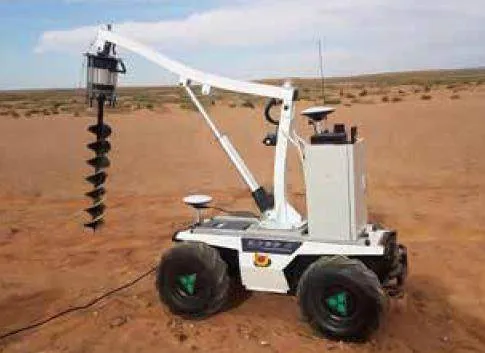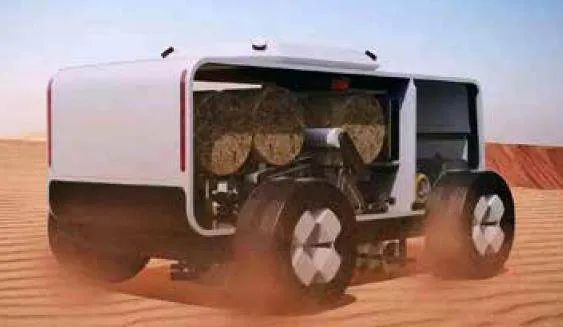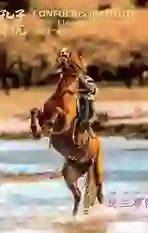内蒙古的治沙新妙招
2024-01-01李玉白





内蒙古自治区地处中国北部边疆,东西绵延2 400多公里,自西向东分布着四大沙漠和四大沙地。但内蒙古人民通过自己的双手,在荒漠中创造了一片片令人瞩目的“绿色奇迹”。如今,科技的进步更是为治沙工作带来了翻天覆地的变化。内蒙古人民将传统智慧与现代科技相结合,创造出一系列治沙的新“招式”。那么他们到底有些什么样的“治沙秘籍”呢?
Stretching over 2,400 kilometers fromeast to west, Inner Mongolia in North Chinais home to four major deserts and vast sandyregions. Yet, through hard work, the peopleof Inner Mongolia have achieved remarkable“green miracles” in these once barrenlandscapes. Today, technological advancementshave further revolutionized their desertificationcontrol efforts. By blending traditional wisdomwith modern technology, they’ve developeda range of innovative techniques to combatdesert encroachment. But what exactly are their“secret weapons”?
吞沙巨兽
Sand-swallowing Beasts
在过去,防沙治沙主要依赖人工,效率相对较低。现在,科技的发展给我们带来了新的工具——多功能立体固沙车,这就是人们所说的“吞沙巨兽”。它的外形有点像大型拖拉机,可以在沙漠地区进行植物播种、灌溉等多种操作,将治沙和造林合二为一。首先,“吞沙巨兽”会将麦草、稻草等原材料压缩成卷,放入车内的专门草料箱中,之后它会自动分配这些草料,并将其植入深约25厘米的沙地中,形成稳固的草方格沙障。这样的草方格能够有效地防风固沙,保持沙漠中的水分,为植物生长提供良好的土壤环境,故被称为“固沙魔方”。
In the past, efforts to combat desertificationrelied heavily on manual labor, which was relativelyinefficient. Today, technological advances haveintroduced a new type of multi-functional sandfixingvehicle, nicknamed the “sand-swallowingbeast.” Resembling a large tractor, this machinecombines planting and irrigation and other tasksinto one process, making it highly effective for bothdesert management and afforestation. The processbegins with the “sand-swallowing beast” compressingmaterials like wheat straw and rice straw into rolls,which are then loaded into a special compartmentwithin the vehicle. It automatically distributes andplants these materials into the sand, embedding themabout 25 centimeters deep to create robust strawgrid barriers. These grids help reduce wind erosion,stabilize sand, and retain moisture, creating an idealenvironment for plant growth. For this reason, themachine is also dubbed the “sand-stabilizing magiccube.”
“吞沙巨兽”的工作效果是非常惊人的。据操作人员介绍,一台固沙车每小时能种下2 000株植物,覆盖沙地面积8.5亩,相当于人工治沙的50 ~ 80 倍。此外,固沙车还能根据沙地的具体条件,灵活调整相关参数,以适应不同种类的植物生长,提高植物的存活率。数据表明,在采用“吞沙巨兽”进行沙漠绿化的地区,植物的存活率大于80%,而且生长速度也比人工种植的快很多。
The efficiency of the “sand-swallowing beast”is impressive. Operators report that a single vehiclecan plant up to 2,000 plants per hour, covering anarea of 8.5 mu (about 1.4 acres) of desert — makingit 50 to 80 times more efficient than manual labor.The vehicle’s parameters can be adjusted based on thetype of sand and the plants being grown, significantlyincreasing the survival rate of the vegetation. In areaswhere the machine has been deployed, plant survivalrates exceed 80%, and growth is noticeably fastercompared to manual planting.
因此, 在短短的一年内, 腾格里沙漠南部边缘形成了2 000多亩的草方格沙障,组成了坚实的防沙屏障。
As a result, in just one year, over 2,000 mu(about 329 acres) of straw grid sand barriers havebeen established along the southern edge of theTengger Desert, creating a powerful shield againstdesertification.
护林特工
Forest Protection Agents
在库布齐沙漠恩格贝生态示范区植树现场,新型“护林特工”——无人植树机器人正在栽种沙柳苗。一排长约30米的沙柳苗栽种下来,整个过程不到2分钟。这款机器人融合了多项技术,可以实现无人化、规模化、全天候种植作业,它的种植效率相较于传统人工种植提高了近40 倍。
At the tree planting site in the Engebei EcologicalDemonstration Zone of the Kubuqi Desert, a newtype of “forest protection agents” — unmannedtree-planting robots — has been hard at work. Thisadvanced machine can plant a row of desert willowseedlings about 30 meters long in under two minutes.By integrating cutting-edge technologies, this robotenables automated, large-scale, all-weather plantingoperations, boasting an efficiency nearly 40 timesgreater than traditional manual planting.
这种新型的“特工”可以利用卫星定位、物联网、人工智能和云服务技术进行自动化种植。在植被生长期,人们就可以通过云端远程管理系统,对植被进行精准定位和定期观测。
This innovative “agent” is equipped with satellitepositioning, the Internet of Things (IoT), artificialintelligence, and cloud service technology, allowing forfully automated planting. Once the seedlings are in theground, the growth process is monitored remotely viaa cloud-based system, providing precise positioningand real-time updates on the vegetation’s progress.
在一些地形复杂、人工造林困难的地区,植树机器人可以适应不同的地形条件,进行有效的造林作业。此外,相较于人工造林,“植树机器人”成本低、易于生产和组装,也更易于大规模运用。
In areas with difficult terrain, where manualplanting is challenging, these robots adapt easily tovarious land conditions, making afforestation effortsmore efficient. Not only are they more cost-effectivethan manual labor, but they’re also easier to produceand assemble, making them ideal for large-scaleapplication.
沙漠“神话”
A Desert “Miracle”
把黄河的水引到沙漠,这在很多人看来仿佛是天方夜谭。但在内蒙古,十年时间,这个神话变成了现实。
Bringing water from the Yellow River intothe desert might sound like a fantasy, but in InnerMongolia, a decade of dedicated effort has made it areality.
库布齐沙漠位于河套平原黄河“几”字弯南岸,该地及周边区域水资源非常匮乏,草原、森林、湖泊等众多自然生态系统都面临严重的退化和破坏。在库布齐沙漠生态治理的初期,人们主要采取退耕还林、还草以及植树造林的方式,但因水资源短缺,收效比较小。2013年,国家决定实施“引黄入沙”工程,将黄河水引入库布齐沙漠腹地。
The Kubuqi Desert lies on the southern bankof the Yellow River’s iconic upside-down “U”-shaped bend in the Hetao Plain, an area that haslong suffered from severe water shortages. Naturalecosystems, including grasslands, forests, and lakes,have been heavily degraded. Early efforts at ecologicalrestoration, such as converting farmland back toforests and grasslands and planting trees, met withlimited success due to the lack of water. Then in 2013,the government launched the ambitious Yellow RiverWater Diversion Project, channeling water deep intothe heart of the Kubuqi Desert.
经过近十年的努力,沙漠渐渐变湿地,水鸟和野生动物也纷纷赶来定居。当地百姓积极参与,造生态围堤,筑绿色屏障,还建起淤泥坝和退水闸,在枯水期还清水于黄河。几年下来,库布齐沙漠已建成近100平方公里的湿地,相当于14 000个标准足球场。
After nearly a decade of hard work, the oncearid desert has slowly transformed into wetlands,attracting waterfowl and wildlife to return. Localresidents have played a key role in the restoration,building ecological embankments, creating greenbarriers, and constructing silt dams and drainagegates to ensure clear water is returned to the YellowRiver during dry seasons. Today, the Kubuqi Desertboasts nearly 100 square kilometers of wetlands — anarea equivalent to 14,000 standard football fields.
环境改善后,当地人开始圈起牛羊,种起庄稼,甚至还有人养起了螃蟹,通过治沙走上致富之路。“引黄入沙”工程创造了绿色奇迹,因其卓越的成果,该工程获得了联合国的年度土地生命奖,成为世界荒漠化治理的典范。
As the environment improved, local peoplebegan raising cattle and sheep, planting crops, andeven farming crabs, turning desert control into apath to prosperity. The Yellow River Water DiversionProject has become a green miracle and was awardedthe United Nations Land for Life Award, making it aglobal model for desertification control.
昔日黄沙漫天,今朝绿意盎然。这不仅仅是自然景观的变迁,更是人民生活方式的转变。大自然在内蒙古大地上留下了大片沙漠的印记,几十年来,人与沙的较量,黄与绿的交锋,是内蒙古大地上最生动的图景。在欣赏如此之美景时, 让我们对治沙人坚韧不拔、勇于创新的精神致以深深的敬意。
What was once an endless expanse of yellowsand is now a landscape teeming with greenery. Thistransformation is not only a change in the scenery,but a shift in the way people live. Nature gave InnerMongolia deserts, and for decades, the most vividmemory here has been the harsh struggle betweenhumans and nature, between yellow and green.As we admire this remarkable landscape, we mustalso honor those who have battled the desert withresilience and innovation.
